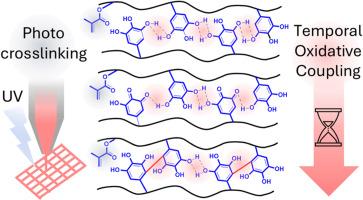通过ph控制氧化和光交联的双交联加仑生物墨水,具有增强的剪切减薄和粘弹性行为
Q1 Computer Science
引用次数: 0
摘要
我们的研究工作提出了一种双交联方法来解决生物打印中胆醇介导的自氧化方法的局限性,在生物打印中,快速的氧化交联可能导致过早凝胶化,导致堵塞或打印失败。我们通过利用其时间剪切变薄特性,使加仑水凝胶油墨能够通过基于挤出的3D生物打印进行打印。通过提高pH值,可以触发胆碱修饰的甲基丙烯酸透明质酸(HAMA-GA)之间的相互作用,形成弱水凝胶。这一特性为水凝胶提供了可注射性和可挤压性。随后的光交联导致不确定氧化交联。在光交联过程中,紫外光部分抑制了HAMA-GA的氧化偶联。结果,打印的水凝胶形成了包含氧化和光诱导键的双交联网络,随着时间的推移,这有助于增强结构稳定性。我们提出的方法解决了胆醇介导氧化的挑战,包括阻碍3D生物打印挤出的过凝胶,为提高打印性和形状保真度提供了一个有希望的解决方案。HAMA-GA墨水可在pH 5.5下使用基于挤压的3D打印机进行生物打印,显示出细胞相容性(约95%存活率)。这一策略对于设计具有可调性能的水凝胶油墨用于3D生物打印,同时保持加仑尔部分的组织粘附性能是有价值的。本文章由计算机程序翻译,如有差异,请以英文原文为准。

Dual-crosslinkable gallol bioinks via pH-controlled oxidation and photocrosslinking with enhanced shear thinning and viscoelastic behavior
Our research work proposes a dual crosslinking approach to address the limitations of the gallol-mediated auto-oxidation approach in bioprinting, where rapid oxidative crosslinking can cause premature gelation, leading to clogging or printing failure. We enabled a gallol hydrogel ink to be printable via extrusion-based 3D bioprinting by utilizing its temporal shear-thinning properties. By raising the pH level, interactions between gallol-modified hyaluronic acid methacrylate (HAMA-GA) can be triggered to form a weak hydrogel. This feature provides injectability and extrudability for the hydrogels. Subsequent photocrosslinking results in indefinite oxidative crosslinking. The oxidative coupling in HAMA-GA was partially inhibited by UV light during the photocrosslinking step. As a result, the printed hydrogel formed a dual-crosslinked network containing both oxidative and photo-induced bonds, which contributed to enhanced structural stability over time. Our proposed approach addresses the challenges of gallol-mediated oxidation, including overgelation that hinders extrusion in 3D bioprinting, offering a promising solution for improved printability and shape fidelity. HAMA-GA ink was bioprintable at pH 5.5 using an extrusion-based 3D printer, showing cytocompatibility (∼95 % viability). This strategy is valuable for designing hydrogel inks with tunable properties for 3D bioprinting while maintaining tissue adhesive properties of gallol moieties.
求助全文
通过发布文献求助,成功后即可免费获取论文全文。
去求助
来源期刊

Bioprinting
Computer Science-Computer Science Applications
CiteScore
11.50
自引率
0.00%
发文量
72
审稿时长
68 days
期刊介绍:
Bioprinting is a broad-spectrum, multidisciplinary journal that covers all aspects of 3D fabrication technology involving biological tissues, organs and cells for medical and biotechnology applications. Topics covered include nanomaterials, biomaterials, scaffolds, 3D printing technology, imaging and CAD/CAM software and hardware, post-printing bioreactor maturation, cell and biological factor patterning, biofabrication, tissue engineering and other applications of 3D bioprinting technology. Bioprinting publishes research reports describing novel results with high clinical significance in all areas of 3D bioprinting research. Bioprinting issues contain a wide variety of review and analysis articles covering topics relevant to 3D bioprinting ranging from basic biological, material and technical advances to pre-clinical and clinical applications of 3D bioprinting.
 求助内容:
求助内容: 应助结果提醒方式:
应助结果提醒方式:


